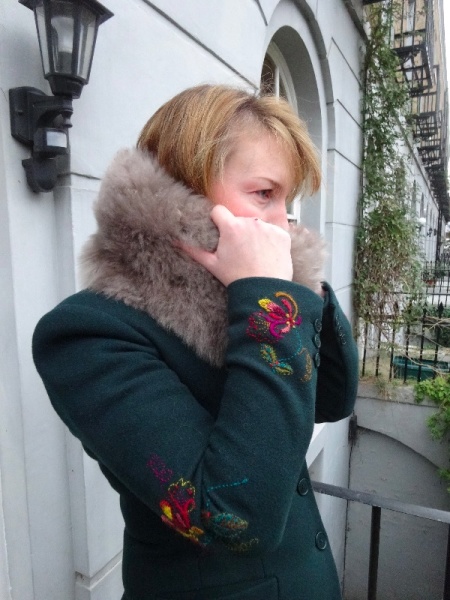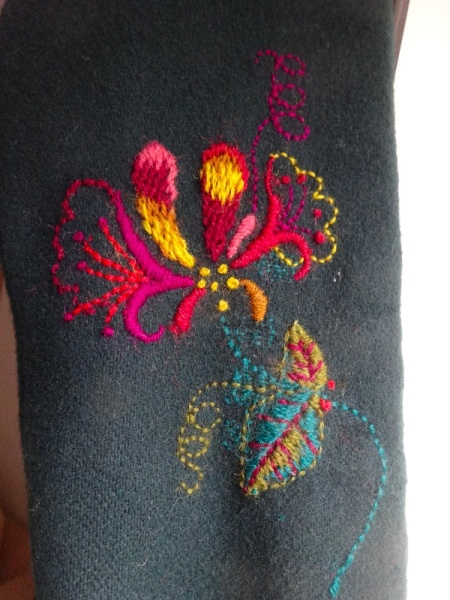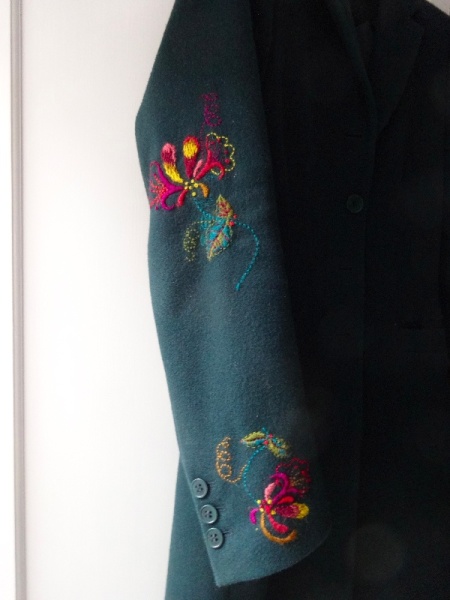Inadequate packing has meant an enforced break from craft activity. I have wool but no needles (Loop’s combination of narrow doors and 2 awkward steps looked beyond my navigation skills in charge of one of those giant all singing and dancing super buggies) and linen but no light box, so no transferring my embroidery design from paper to fabric. Thus thwarted I ran through some pictures on iPhoto and came upon a photo which I thought I had lost. Before I lose it again, I’ll blog about it.
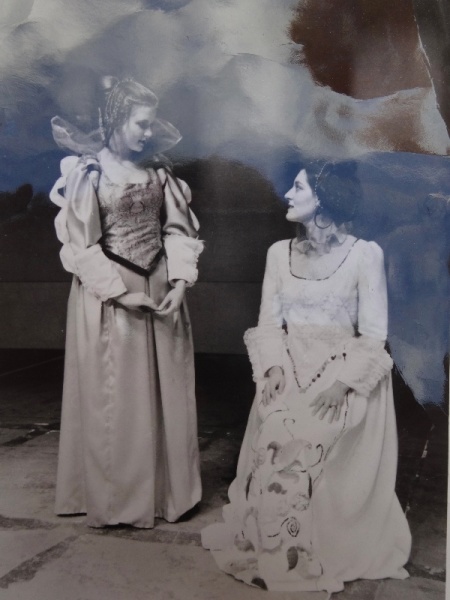
Alison Stamp as Cariola and Jillian Crowe as the duchess in Stephen Oliver’s 1971 Oxford Playhouse production of his opera ‘The Duchess of Malfi’
When I was an undergraduate at Oxford, I got into making theatrical costumes and somehow I found myself in charge of providing them for the university’s opera society which was on a bit of a high at the time. The previous year they had put on a wonderful ‘Marriage of Figaro’ conducted by Jane Glover and directed by Julian Hope who both later found national and international fame conducting and producing respectively (also to become famous – though for reasons other than for his singing – was Oz Clarke who slipped easily into the role of the drunken gardener). 1971, the next year, saw the Opera Society premiering a new opera ‘The Duchess of Malfi’ by undergraduate Stephen Oliver (only 21, he already had a string of original scores behind him).
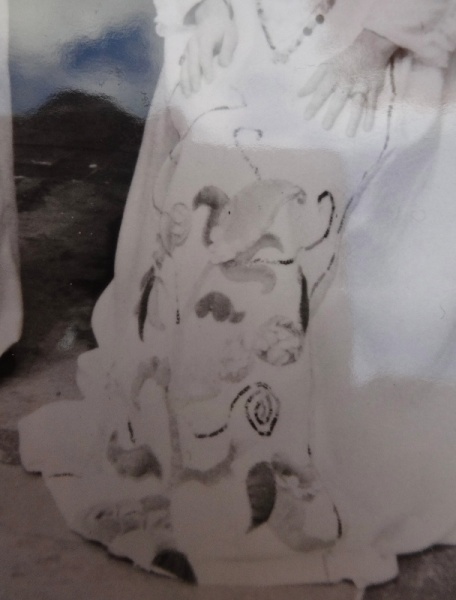
‘The Duchess of Malfi’, an opera by Stephen Oliver: detail of the duchesse’s dress with Jacobean tree of life.
Based on the Jacobean tragedy of the same name by John Webster of 1612/13, the opera is a dark disturbing piece of incestuous desires, greed of worldly goods and plenty of murder. The leitmotif of the opera “My sister, Oh, my sister, there’s the cause of it”, with its catchy atonal (ish – I think) musical line haunted all who heard it and many of us were probably thought unhinged as we wandered round colleges making strange strangulated attempts on the phrase. Musically the opera was well received with reviews in several national papers. It is to my everlasting shame as wardrobe mistress that one eagle-eyed reviewer focused on the Duchess’s brother Ferdinand whose feet were clearly shod in all too anachronistic desert boots (my costumier’s Waterloo, as I ran out of energy and time to source something better than his own shoes). Sadly there was no admiration for my Duchess’s dress with its appliquéd tree of life in velvets and gold thread. I had also made Cariola’s dress which you see in the photo (all the others were hired). Hey ho – I don’t think it bothered me for long as I was probably too exhausted (and exhilarated by the experience) and anyway university life had to carry on with no let up on the 2 weekly essays.
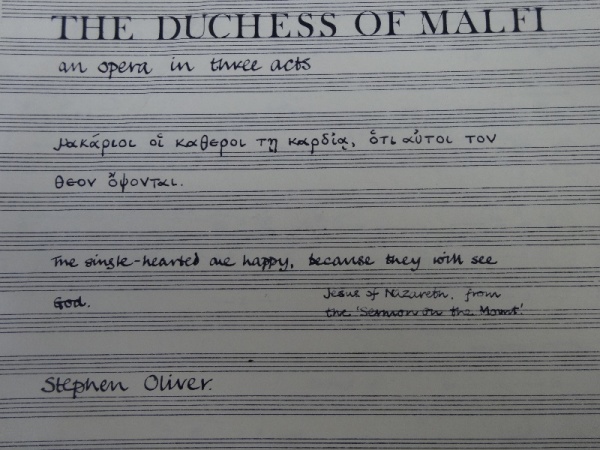
Frontispiece of score of ‘The Duchess of Malfi’ an opera by Stephen Oliver
Stephen continued writing like an unstoppable spring, in multiple genres from incidental music for television programmes to more operas. He provided music and lyrics for the mould breaking RSC Nicholas Nickleby of 1980 and in the next year he produced a stunning musical score for Radio 4’s adaptation of Lord of the Rings (do listen to it). Less successful was ‘Blondel’ a collaboration with Tim Rice in 1983. He also wrote music for many television productions of Shakespeare, most notably a series produced by Jonathan Miller. Of his more than 40 operas, his last, ‘Timon of Athens’ he considered to be his best and the one he believed he was made to write. He made a good deal of money from his music but lived simply and ploughed most of it back into supporting small opera companies and individuals going through hard times. Stephen died from Aids related complications in 1992. His archive is now available in the British Library. Somehow I seem to have a copy of the full musical score.
It is strange to think how badly documented the recent past is. It seems to sit in a lacuna just before the internet burst into our lives and enabled ordinary people like me to write about whatever takes their fancy. An internet search on this opera and those who sang in it reveals very little and no photographs. It gives me pleasure to think that my single photograph is now available to be viewed.
Do read this Independent article of 2010 by the actor Simon Callow who knew Stephen well and writes vividly about his friend.
Black Saturday: The world has gone mad. Without really thinking things out I caught the bus into Oxford Circus yesterday to replace my forgotten sewing/knitting equipment only to discover traffic – and even human – gridlock as the world and his wife was descending to take advantage of the Black Friday to Black Monday price cuts. (Bhs had 50% off and even Anthropologie cut all prices by 20%). Buses became stationary on Oxford Street and ours wasn’t the only one to decide to terminate there. The pavements rippled and surged with carrier bag festooned people doggedly pursuing their course for all the world like hunting dogs on a fresh scent. Just Liberty and John Lewis for me today then. But Liberty – after what must have been a successful TV airing – was more full than it could afford to be and through flow was minimal. The fact that I was stuck in a lift for 15 minutes may not have helped. (The lift very clearly said ‘6 people only’. There were already 3 of us when 3 very large, well spoken men of misjudged and overconfident charm decided it would be good to join us. Somewhat quizzically I gestured at the ‘6 persons only’ sign but too late for already the door was closing. Seconds later the lift juddered to a halt and the temperature which was already high, began to rise considerably. 6 obviously meant 6 of average size with no leeway. Suffice it to say Liberty staff were very prompt and we were out in 15 minutes – joshing males loudly wondering what their compensation should be. We original 3 were happy to be allowed a trip to our intended floor unimpeded by additional passengers.) After a thankfully early rescue, I headed home with no attempt to shop further. It was fortunate that the bus indicator board suggesting all routes were subject to a delay of about an hour was wrong.

